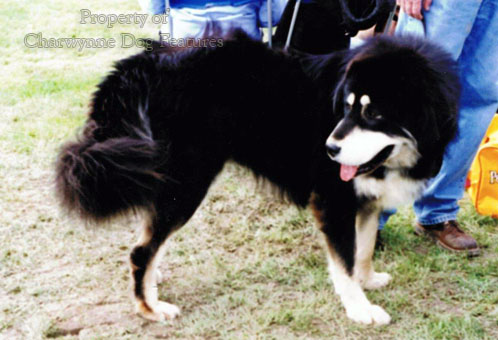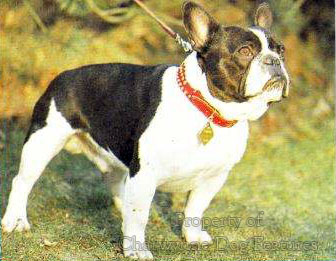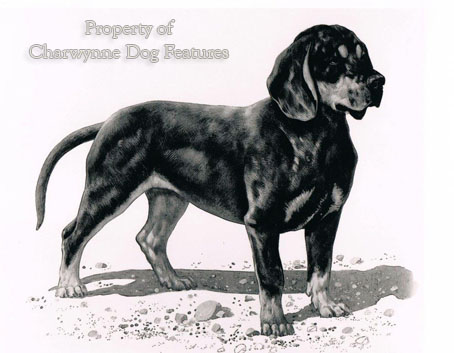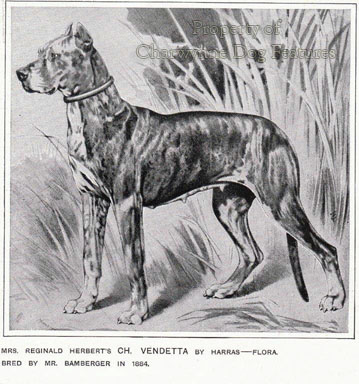234 Breeds into Groups
COLLECTING BREEDS TOGETHER: THE NEED FOR GROUP THERAPY
by David Hancock

 In 1993 the Kennel Club produced a discussion document on the exhibition of dogs which covered amongst other things, proposals for grouping pedigree dog breeds together under collective headings for show purposes. This document invited comment on whether the present six group division is in the interests of shows and exhibitors. The last few words are I believe misdirected. Any revision of groups should be done in the interests of dogs. Of course, as a KC spokesman has pointed out to me, judges should always judge a breed as just that, but this rather simplistic view overlooks the fact that breeds of sighthounds, scenthounds, setters, spaniels, sledge dogs and sheepdogs have common features. When breeds are grouped appropriately, judges with heightened knowledge to offer become available because they are drawn to that type or function.
In 1993 the Kennel Club produced a discussion document on the exhibition of dogs which covered amongst other things, proposals for grouping pedigree dog breeds together under collective headings for show purposes. This document invited comment on whether the present six group division is in the interests of shows and exhibitors. The last few words are I believe misdirected. Any revision of groups should be done in the interests of dogs. Of course, as a KC spokesman has pointed out to me, judges should always judge a breed as just that, but this rather simplistic view overlooks the fact that breeds of sighthounds, scenthounds, setters, spaniels, sledge dogs and sheepdogs have common features. When breeds are grouped appropriately, judges with heightened knowledge to offer become available because they are drawn to that type or function.

I have no particular concern about the overall sub-division of groups into sporting and non-sporting, but I've never liked the terms 'utility' and 'toy' for two of the non-sporting groups. Both sound demeaning to the admirable groups concerned. These two groups are better named 'companion' dogs. If the utility and toy groups combined to form a new companion dog group, it would be made up of some 50 breeds, a little smaller than the current working group. If 50 breeds constitute too many for one group, then sub-groups, perhaps on a size basis, may be called for. The number of breeds per sub-group can be linked to the viability of a show day or indeed a whole show dedicated to such a collection of breeds. But surely administrative convenience comes second to getting really committed and knowledgeable judges?
I understand that the leading kennel clubs hold annual meetings to discuss such matters but international agreement on a group classification is a long way off. When you look at the FCI grouping system and compare it with our own, this state of affairs is easily understood. What is less easily understood is the casual, inaccurate and misleading use of canine nouns in breed titles in both grouping systems. Words like terrier, mastiff and spaniel are used in breed titles in a haphazard almost indifferent manner, so that eventually the words lose all significance. The Tibetan breeds make this point for me very effectively. The word 'Molosser' is used quite incorrectly by the FCI and words like sheepdog, shepherd dog and herding dog are used as substitutes for one another, which they are not. It is high time that nomenclature in breed titles as well as group titles was sorted out and accuracy sought.
The word terrier means an earth-dog, a dog that goes to ground. But it is applied to the Boston terrier and the Tibetan terrier for no sound reason. It could be argued that if the French bulldog title is apt then the Boston terrier would be better named the Boston bulldog. It was once called the round-headed bull and terrier! The Soft-coated Wheaten terrier (why does its coat texture have to feature in its breed title when there is only one coat type in the breed?) and the the Kerry Blue were wonderfully proficient all-round farm dogs; why limit their remarkable versatility to terrier-work in name? On the continent, the Airedale would be called a hunting griffon. No dog two feet high at the withers could go to ground. Why describe such a distinctive purpose-bred hunting dog as merely an earth-dog? It makes no sense at all and insults the wide capability of this outstanding breed.
Within the gundog group, why are the retrievers and spaniels listed together but the pointers and setters not? The American cocker is clearly no longer a sporting breed and arguably no longer a spaniel. How dare another nation steal the name of one of our breeds and get away with it so brazenly! Why isn't the Finnish Spitz in the gundog group? It is a highly competent bark-pointer. The Kooikerhondje is listed in the gundog group but was, and still is in some places, a decoy dog, bred and trained to lure ducks along ever-narrowing wire tunnels into capture cages. This breed did not work to the gun. How can kennel clubs earn respect when their knowledge of dog-use is so limited? 
Our working group is an even bigger mess. No one seems to understand the difference between a mastiff, a mountain dog, a shepherd dog, a sheepdog and a herding dog. The so-called Anatolian shepherd dog and Tibetan mastiff are better described as mountain dogs or flock guardians. The Great Dane is a boarhound and should not be in this group at all. The broad-mouthed breeds: the mastiff, bullmastiff, Neapolitan mastiff and Boxer are descendants of the heavy hounds, the baren-, bufal- and bullenbeissers, which pulled down big game for primitive hunters. The FCI calls all big protective dogs 'molossers'. But the Molossian dog took two forms: the big herd-protector or mountain dog, and a huge hound, as depicted on Molossian coins. The broad-mouthed dogs were quite separate from the Molossian dogs. Using descriptive nouns precisely, the Great Dane and the Dogo Argentino are molossers; the mastiffs are not. Why tolerate wrongly-named breeds? Why not celebrate their individually-distinguished heritage? Why lump them all distainfully together just for administrative convenience?
Breed titles seem to be listed on the basis of anomaly ahead of any sort of defined policy. Why is the Norwegian Buhund not called the Norwegian Cattle Dog if the Portuguese Water Dog is not called the Portuguese Cao de Agua? Why is the Dachshund in the Hound Group when 'hund' means dog not hound? The badgerdog is a terrier; the badger hound is the Dachsbracke. Why is the Miniature Pinscher in the Toy Group when the Miniature Dachshund is in the Hound Group? It makes no sense, especially as the Dachshund, the Pinscher and the Schnauzer are the German equivalent of our terrier breeds. Who is going to sort out this mess? Does it matter?
I believe it matters a great deal whether a breed has the correct breed title and is in the right group. It is important too for the breed standard to state very clearly the function of the breed, even if that function has lapsed. Take the mastiff breeds; if they were judged as heavy hounds once used to 'hold' big game until the primitive hunters arrived, then the attitude of breeders towards movement, athleticism more generally and conformation would change. Such breeds would soon resemble their ancestors once more, be healthier too and be viewed more critically over their show condition. 
The Great Dane, sometimes referred to as the canine 'Apollo', should move like a giant foxhound not like an uncoordinated 'Pluto'. Put the breed where it belongs, in the Hound Group, and let it become regarded as what it once was -- a prized hound of the chase; I'm quite sure the breed would benefit. But if the FCI leave such matters to the country of origin, then the Great Dane will be viewed as just another working breed and its distinguished ancestry ignored. Is that the best way for such a noble breed to thrive? Known to the Germans nowadays as the German Mastiff, but known here over two hundred years ago as the Danish Boarhound, the breed is older than Germany as a sovereign state. But the FCI still regard Germany as its country of origin and therefore the one with the major say.
We have inherited these magnificent breeds from master-breeders who valued function ahead of fancy. Administrative convenience and sloppy nomenclature have no place in the pursuit of excellence in dog breeding. No doubt a committee of bureaucrats will come up with an answer soon! Predictably it will place compromise ahead of correctness. Britain created more breeds of dog than any other and needs to be resolute in their recognition and defence. I do hope that our own Kennel Club will have a huge influence on such deliberations -- after all, it exists solely 'for the improvement of dogs'.